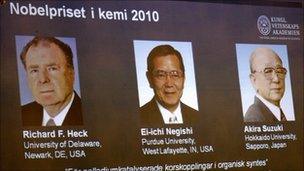Molecule building work wins Nobel
- Published

The method has allowed scientists to make drugs and improved electronics
Three scientists have shared this year's Nobel Prize in Chemistry for developing new ways of linking carbon atoms together.
The Nobel was awarded to Professors Richard Heck, Ei-ichi Negishi and Akira Suzuki for innovative ways of developing complex molecules.
The chemical method developed by the researchers has allowed scientists to make medicines and better electronics.
The Nobels are valued at 10m Swedish kronor (ÂĢ900,000; 1m euros; $1.5m).
The Royal Swedish Academy of Sciences said honours the researchers' development of "palladium-catalysed cross couplings in organic systems".
The academy said it was a "precise and efficient" tool that is used by researchers worldwide, "as well as in the commercial production of for example pharmaceuticals and molecules used in the electronics industry".
Such chemicals included one found in small quantities in a sea sponge, which scientists aim to use to fight cancer cells. Researchers can now artificially produce this substance, called discodermolide.
Heck, 79, is a professor emeritus at the University of Delaware, US; Negishi, 75, is a chemistry professor at Purdue University in West Lafayette, Indiana, and 80-year-old Suzuki is a professor at Hokkaido University in Sapporo, Japan.
Professor Negishi told reporters in Stockholm by telephone that he was asleep when the call from the Nobel committee came.
'Essential tools'
"I went to bed last night well past midnight so I was sleeping but I am extremely happy to receive the telephone call," he said.
Organic chemistry has built on nature, utilising carbon's ability to provide a stable skeleton for functional molecules. This has paved the way for new medicines and improved materials.
To do this, chemists need to be able to join carbon atoms together, but carbon atoms do not easily react with one another.
The first methods used by chemists to bind carbon atoms together were based on making carbon more reactive.
This worked well for synthesising simple molecules, but when chemists tried to scale this up to more complex ones, too many unwanted by-products were generated.
The method based around the metal palladium solved that problem: in it, carbon atoms meet on a palladium atom, and their proximity to one another kick-starts the chemical reaction.
PM's call
Japanese Prime Minister Naoto Kan said he spoke to Professor Suzuki on the phone and congratulated him.
"He told me that Japan's science and technology is at the world's top level and encouraged me to make good use of the resources," he said.
Professor David Phillips, President of the Royal Society of Chemistry, said these metal-based "coupling" reactions had led to "countless breakthroughs".
He added: "The Heck, Negishi and Suzuki reactions make possible the vital fluorescent marking that underpins DNA sequencing, and are essential tools for synthetic chemists creating complex new drugs and polymers."
Russian-born Andre Geim, 51, and Konstantin Novoselov, 36, of the University of Manchester, UK, were awarded the Nobel Prize for Physics on Tuesday for groundbreaking experiments with graphene, an ultra-thin and super-strong material.
The prizes also cover chemistry, medicine, literature, peace and economics.
- Published5 October 2010